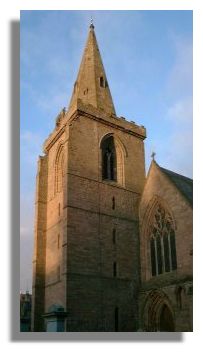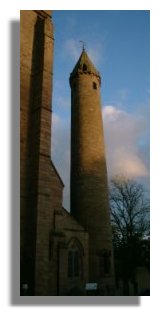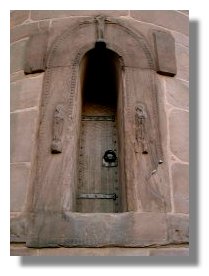Brechin Cathedral History
 In the old days, a city was defined as an important town and had a cathedral. In recent years, the designation of "city" has been by royal charter - and Inverness has become a city. But Brechin used to be regarded as a city - now only the local football team is called "Brechin City". (Opponents sometimes refer to them provocatively as "Brechin City Nil" as that is said to be their usual score-line!).
In the old days, a city was defined as an important town and had a cathedral. In recent years, the designation of "city" has been by royal charter - and Inverness has become a city. But Brechin used to be regarded as a city - now only the local football team is called "Brechin City". (Opponents sometimes refer to them provocatively as "Brechin City Nil" as that is said to be their usual score-line!).
There may have been a church in the Brechin area as early as the beginning of the 8th century but there is certainly evidence for a church in the early 9th century in the form a Pictish cross-slab, known as the St Mary stone, which is still preserved in the present cathedral.
An order of priests called Céli Dé (Servants of God) came to Scotland from Ireland soon after 800 AD and became established in Dunkeld and St Andrews (both part of Pictland at that time) and it seems likely that this religious order was established at Brechin too. The church lands were surrounded by a ditch on one side and backed onto the river Esk. Certainly, by the late 10th century a chronicle of the reigns of Scottish kings from Kenneth MacAlpin (843-858) to Kenneth II (971-995) was compiled in Brechin. This document states that Kenneth II "gave the great city of Brechin to the Lord" and a stone carving in the cathedral dated from the early 11th century represent a bishop (with a typical Celtic crozier or staff of a bishop of the Céli Dé.
 It appears that the position of bishop of Brechin was a hereditary one by the 10th century and in the 12th century all the leading positions were held by one family named Samson. This was in the days before celibacy was imposed.
It appears that the position of bishop of Brechin was a hereditary one by the 10th century and in the 12th century all the leading positions were held by one family named Samson. This was in the days before celibacy was imposed.
The present cathedral building (not large by cathedral standards) dates from the early 13th century and the square tower from the 14th century. But during restoration work, stones from a Norman Romanesque arch were found dating from around 1130 to 1150 and there is speculation that a new church was built at that time (during the tenure of Bishop Samson).
In addition to the Pictish carvings located within the cathedral, the building has some excellent stained-glass windows. These are of more recent origin - the cathedral fell into disrepair after the Reformation in the 16th century but has since been restored. It is now used as the local parish church.
Brechin Round Tower
 Free-standing round towers were built in Ireland between 900 and 1180 and were called "cloichtheach" in Gaelic - literally "bell-house" though they were used only for large hand-bells to summon the monks to their devotions. Around 60 are known in Ireland (though only about a dozen remain complete). There are two in Scotland - one at Abernethy and the other in Brechin - the latter being the oldest, built around 1000 AD.
Free-standing round towers were built in Ireland between 900 and 1180 and were called "cloichtheach" in Gaelic - literally "bell-house" though they were used only for large hand-bells to summon the monks to their devotions. Around 60 are known in Ireland (though only about a dozen remain complete). There are two in Scotland - one at Abernethy and the other in Brechin - the latter being the oldest, built around 1000 AD.
The tower at Brechin is 86 feet to the wallhead and over 106 feet to the apex of the octagonal cap-house (which replaced a conical one in the late 14th century. Although externally the tower narrows towards the top the internal diameter does not change much through the seven floors to the top. The towers were used as libraries and for keeping valuables and as refuges in times of violent attack.
 The doorway to the tower is six feet above the ground (which was frequently the case with such towers) but the construction is unique and so is the rich decoration (although it bears some resemblance to the tower at the ecclesiastical centre at Kells in Ireland). Although worn by the passage of time, there is a carving of the crucifixion at the top, two further figures on each side and decorative mouldings around the stone arches.
The doorway to the tower is six feet above the ground (which was frequently the case with such towers) but the construction is unique and so is the rich decoration (although it bears some resemblance to the tower at the ecclesiastical centre at Kells in Ireland). Although worn by the passage of time, there is a carving of the crucifixion at the top, two further figures on each side and decorative mouldings around the stone arches.
The Round Tower was built a few hundred years before the present cathedral but was incorporated into it at its south-west corner.



